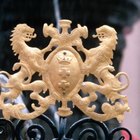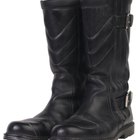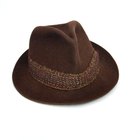
Kitty Ellis/iStock/Getty Images
The black and white abstract checkerboard pattern with a vague resemblance to a chicken-foot print -- known in French as the pied de poule and in English as houndstooth -- first appeared in the 1800s in the Scottish lowlands. Then, it was called Shepherd's check or Dogtooth, and was mostly used on woven wool cloth outerwear for sheepherders. Today, the duo-tone pattern can be found on everything from tweed jackets to designer stiletto heels.
Scottish Heritage
In the 1920s, Scottish clans commandeered the notably original check from the sheepherders to claim for their tartan designs. And while Scottish clans are notoriously hostile about outsiders wearing the patterns of their tartans, houndstooth is the neutral Switzerland of the tartan world. The check pattern was never officially registered by any one clan, as is the tradition when a clan chooses a tartan to represent them.
A Symbol for Wealth
Mirriam-Webster doesn't record the first use of the term "houndstooth" until 1936. It was in this decade of the turbulent thirties that houndstooth became a symbol of wealth by the upper class when then Prince of Wales, Edward the VII, Duke of Windsor, chose the check for his everyday wear. Wool fabric houses worked closely with royal tailors to design elegant houndstooth suits to the Prince's liking. The more the Prince was seen in houndstooth, the more apparel manufacturers produced designs with the print for the general public. The need for newer and more exciting versions of the check gave British manufacturers a healthy financial boost from both domestic and international demand.
Houndstooth Goes International
The Brits couldn't keep houndstooth to themselves forever, and in 1959, French high-fashion designer Christian Dior began incorporating the pattern into his designs. Rather than weaving the pattern, as was the style of the British, Dior and subsequent designers, including Louis Vuitton and Chanel, would instead print the distinctive shapes onto fabric for their women's wear collections. By 1965, Americans had finally caught the houndstooth bug, with designer Geoffrey Beene pairing the pattern with lace on his dresses for society women. Beene also veered away from the traditional black and white check to more colorful statements of lavender with charcoal and green, and caramel with black.
An Undying Print
Houndstooth has come quite a long way from its early beginnings on the backs of sheepherders. In 2003, Japanese designer Yohji Yamamoto created his entire fall collection -- from oversized coats to chiffon ball gowns -- with houndstooth in the design. 2009 saw houndstooth featured in almost every major international runway show, from British designer Alexander McQueen to the Italian brand Moschino. Moving beyond apparel and outerwear, houndstooth has found its way into hats, shoes and even home accessories. The check with modest origins has become a pattern wildly adored by the international fashion crowd.
Related Articles

Types of Burberry Plaid

The History of Denim Jackets

The Difference Between Houndstooth & ...

1958 Men's and Women's Dress Styles

Letterman Jackets in the '50s

Zoot Suit vs. Victory Suit

How to Date a Brooch

Wedding Dresses of the 1920s, 1930s & ...

What Is the Difference between a Coat ...

The Proper Name of German Boots in WWII

The History of Tweed Perfume

How to Tell the Age of a Vintage Navy ...

1950s Gangster Clothes

The History of Pinstripe Suits

What Are Psychedelic Clothes?

Christian Dior's Contributions to ...

Lacoste Vs. Ralph Lauren

What Is the Difference Between Denim & ...

How to Dress Like Bono

Why Is It Called a Pea Coat?
References
- Vogue Italia Encyclopedia: Houndstooth Check; Damiana Biga
- David Bailey's World of Escher-like Tessellations: Houndstooth – The World’s Most Popular Tessellation; But Why?
- Scottish Tartans Museum: What is Tartan?
- The Independent: Ready to Wear -- Houndstooth is Fierce, and Signifies Power Over and Above Prettiness; Susannah Frankel
Writer Bio
Lilian M Raji is a strategic marketing and public relations adviser for luxury lifestyle companies in the areas of fine jewelry and watches, fashion, accessories, beauty, cosmetics, restaurants and hotels. Equally passionate about writing as she is developing and executing business strategy, she has been published on Forbes.com, Luxury Society, "The Village of Merrick Park Magazine" and "Canadian Jeweller Magazine."
Photo Credits
Kitty Ellis/iStock/Getty Images